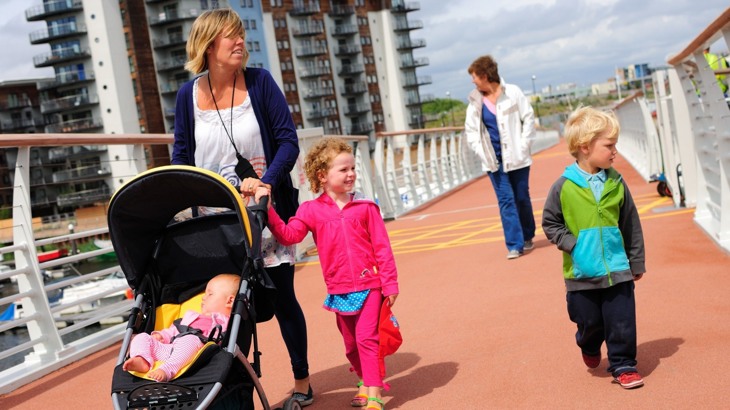Measures to support walking and cycling should feature heavily in plans to improve air quality. Transport emissions are among the major causes of air pollution in our towns and cities. Throughout the UK, local authorities are coming up with plans for how to address this challenge.

And soon we will be releasing a new tool to help to support the case in favour of walking and cycling measures.
The extent of the problem posed by air pollution has been well covered recently. Government action is long overdue. But there are many interests vying for attention in the possible mix of measures to reduce emissions from transport. We set out why walking and cycling solutions provide a better option.
Measures to eliminate diesel from the car fleet are sensible, but the extent of change to air quality that will result is limited. A large proportion of particulate matter emissions from cars come from brake and tyre wear – diesel elimination does not alter this. And petrol combustion is still an air pollutant, albeit less bad than diesel. Also, the administration of scrappage schemes is notoriously hard to manage, and funding often ends up benefitting people who don’t really need the financial support. Scrappage schemes that are wholly publically funded should not be considered as an appropriate solution, as they do not represent the best use of public sector funds.
Some of the same problems apply to the electrification of the car fleet. The same issue of emissions from brake and tyre wear apply, and the energy sourcing simply displaces the problem of combustion emissions from the exhaust pipe to the power station chimney. Increasing the extent of the electrification of the fleet increases demand for generation of electricity, and the consequent use of more fossil fuels (although the current mix of energy supply is improving, significant changes in demand will necessitate continued use of older, dirty energy generation methods for some time to come). In addition, the extra weight of batteries (significantly heavier than fuel tanks) mean that particulate matter from tyre and brake wear will be higher.
Public transport has a major role to play in supporting a move away from private vehicles. The electrification of public transport will help, but again we need to be mindful of electricity demand implications and the associated generation issues. Public transport users certainly deserve cleaner fleets – research suggests that exposure to poor air quality on public transport is uncomfortably high*. And we should also be mindful that large parts of the public transport network are already operating at close to capacity in peak hours – dealing with high demand by expanding the fleet, even with cleaner vehicles, will exacerbate energy demand issues.
Limiting the access of private vehicles in urban areas is a more positive solution. The most effective way to clean an area is to remove the root cause of the problem. Whether traffic restraint is applied in certain hours of the day, or in certain streets or areas, the air quality outcome should be positive – provided that care is taken not to displace the problem, such as drivers finding a different (longer?) route to their destination or businesses relocating to areas without traffic restraint (although many observers suggest that the reverse case is more likely – businesses will opt to move in to less polluted areas). Charging for access is worth considering, but must be coupled with significant investment in cycling and walking infrastructure and public transport to give people alternative ways to travel and avoid penalising the less wealthy.
Notwithstanding the question of charging, the major challenge of traffic restraint is accessibility. Whatever measures are implemented, people must have the means to get to their destinations.
The best alternative to these options, is measures that support walking and cycling. There are no additional emissions or energy demand implications, active travel can be fully inclusive, and accessibility is supported.
Of course, the reality is that a combination of appropriate measures is probably the most effective approach to reducing polluting emissions from transport. We want to see all plans for air quality improvement underpinned by measures to support walking and cycling.
A new tool developed by Sustrans and Eunomia supports making the case for walking and cycling measures in terms of air quality. It shows how to get the best value in terms of air quality from supporting walking and cycling, and sets a framework for how to build plans for walking and cycling into plans to improve air quality.
Sustrans will welcome the opportunity to engage with people responsible for plans to address the air quality challenge to show how our tool can help. For more information about the air quality tool, please contact Dr Andy Cope.
Sources
De Nazelle, A., Fruin, S., Westerdahl, D., Martinez, D., Ripoll, A., Kubesch, N., and Nieuwenhuijsen, M. (2012) A travel mode comparison of commuters’ exposures to air pollutants in Barcelona, Atmospheric Environment, Vol.59, pp.151–159
Zuurbier, M., Hoek, G., Hazel, P. van den, and Brunekreef, B. (2009) Minute ventilation of cyclists, car and bus passengers: an experimental study, Environmental Health, Vol.8, No.1, p.48
Zuurbier, M., Hoek, G., Oldenwening, M., Lenters, V., Meliefste, K., van den Hazel, P., and Brunekreef, B. (2010) Commuters’ Exposure to Particulate Matter Air Pollution Is Affected by Mode of Transport, Fuel Type, and Route, Environmental Health Perspectives, Vol.118, No.6, pp.783–789
Zuurbier, M., Hoek, G., Oldenwening, M., Meliefste, K., van den Hazel, P., and Brunekreef, B. (2011) Respiratory Effects of Commutersʼ Exposure to Air Pollution in Traffic:, Epidemiology, Vol.22, No.2, pp.219–227
Int Panis, L., de Geus, B., Vandenbulcke, G., et al. (2010) Exposure to particulate matter in traffic: A comparison of cyclists and car passengers, Atmospheric Environment, Vol.44, No.19, pp.2263–2270

